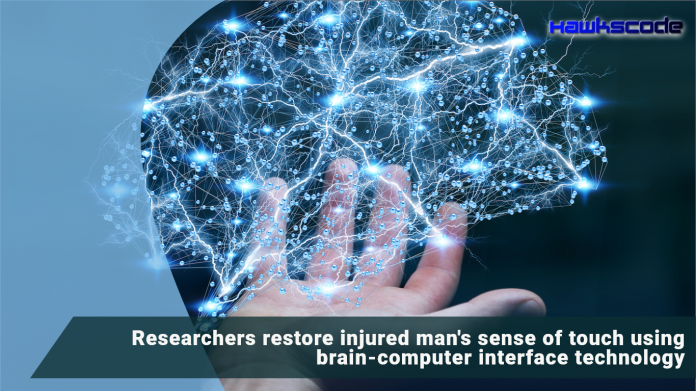Researchers restore injured man’s sense of touch using brain-computer interface technology
Researchers restore injured man’s sense of touch using brain-computer interface technology. While we might often take our sense of touch for granted, for researchers developing technologies to restore limb function in people paralyzed due to spinal cord injury or disease, re-establishing the sense of touch is an essential part of the process. Scientists from Battelle (OH, USA) and Ohio State University Wexner Medical Center (OH, USA) have collaborated to develop a brain–computer interface device that has restored both movement and the sense of touch to the hand of an individual with severe spinal cord injury. To get better understanding of this read Design of inorganic material for brain like computing.

Important Announcement – EasyShiksha has now started Online Internship Program “Ab India Sikhega Ghar Se”

The study involved a single male participant named Ian Burkhart who had suffered a severe spinal cord injury following a driving accident in 2010.
“Until now, at times [Burkhart] has felt like his hand was foreign due to lack of sensory feedback,” commented first author of the study, Patrick Ganzer (Battelle). “He also has trouble with controlling his hand unless he is watching his movements closely. This requires a lot of concentration and makes simple multitasking like drinking a soda while watching TV almost impossible.”
Although Burkharts’ spinal cord injury was considered ‘clinically complete’ and he had almost no sensation in his hand, the researchers determined that electrical stimulation of his skin could still be conveyed to his brain.
Top Courses in Software Engineering
To harness this, the group developed the brain–computer interface device to boost these signals to a level that the brain could perceive and respond to. Using a computer chip implanted into the motor cortex and an array of electrodes on the skin, they allowed electrical signals to bypass the spinal cord.
When fitted with the brain–computer interface device, Burkhart could perform activities such as lifting a coffee cup, swiping a credit card and playing Guitar Hero. “It has been amazing to see the possibilities of sensory information coming from a device that was originally created to only allow me to control my arm in a one-way direction,” concluded Burkhart.
The research group is now working to create a next-generation sleeve of electrodes and sensors that can be easily put on and removed. They also aim to make the device more portable.
I hope you like this blog, Researchers restore injured man’s sense of touch using brain-computer interface technology. To learn more visit HawksCode and Easyshiksha.
Empower your team. Lead the industry
Get a subscription to a library of online courses and digital learning tools for your organization with EasyShiksha
Request NowQ. Are EasyShiksha's internships truly free?
Yes, all internships offered by EasyShiksha are completely free of charge.
Q. How can I apply for an internship with EasyShiksha?
You can apply by visiting our website, browsing available internships, and following the application instructions provided.
Q. What types of internships are available through EasyShiksha?
EasyShiksha offers a wide range of internships across technology, business, marketing, healthcare, and more. Opportunities are continuously updated.
Q. Will I receive a certificate upon completing an internship?
Yes, upon successful completion, you will receive a certificate recognizing your participation and achievements.
Q. Are EasyShiksha's internship certificates recognized by universities and employers?
Yes, the certificates are recognized by universities, colleges, and employers worldwide.
Q. Is the download of certificates free or paid?
Access to internships and courses is free, but there is a small fee to download certificates, covering administrative costs.
Q. When can I start the course?
You can choose any course and start immediately without delay.
Q. What are the course and session timings?
These are fully online courses. You can learn at any time and pace. We recommend following a routine, but it depends on your schedule.
Q. What will happen when my course is over?
After completion, you will have lifetime access to the course for future reference.
Q. Can I download the notes and study material?
Yes, you can access and download course materials and have lifetime access for future reference.
Q. What software/tools would be needed for the course?
All necessary software/tools will be shared during the training as needed.
Q. I’m unable to make a payment. What should I do?
Try using a different card or account. If the problem persists, email us at info@easyshiksha.com.
Q. Do I get the certificate in hard copy?
No, only a soft copy is provided, which can be downloaded and printed if required.
Q. The payment got deducted but shows “failed”. What to do?
Technical errors may cause this. The deducted amount will be returned to your account in 7-10 working days.
Q. Payment was successful but dashboard shows ‘Buy Now’?
Sometimes payment reflection is delayed. If it takes longer than 30 minutes, email info@easyshiksha.com with the payment screenshot.
Q. What is the refund policy?
If you face technical issues, you can request a refund. No refunds are issued once the certificate has been generated.
Q. Can I enroll in a single course?
Yes, select the course of interest, fill in the details, make payment, and start learning. You will also earn a certificate.
Q. My questions are not listed above. I need further help.
Contact us at info@easyshiksha.com for further assistance.
ALSO READ: Mit-developed-sensors-woven-into-fabrics-so-a-shirt-can-monitor
Get Course: Linux-for-Absolute-Beginner



































































